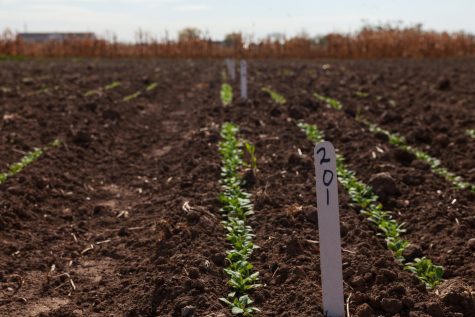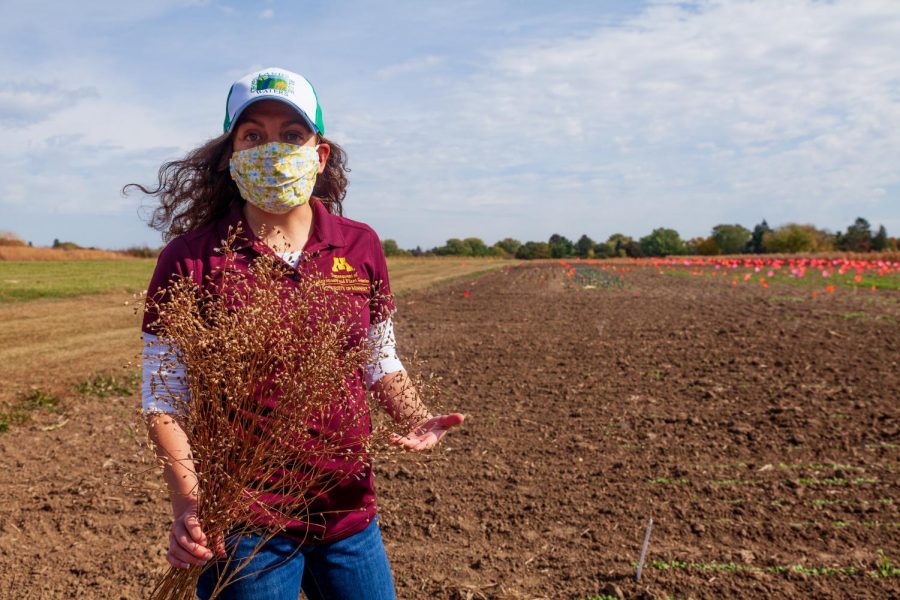Newly planted winter camelina seedlings sprout in little green rows at the University of Minnesota field plots on the St. Paul campus. The winter annual plant is one of 15 breeds University researchers are cultivating to help farmers keep nutrients in their soil, reduce erosion and create a commercially viable product for farmers to sell.
The work comes out of a need to develop crops to cover what some researchers call “the brown period,” the gap between when crops are harvested in the fall and new crops are planted in the spring. During this brown period when there are no plants actively growing in the fields, excess fertilizer can leach into nearby rivers and streams. Cover crops like winter camelina can prevent that.
The project comprises a team of researchers working on a variety of different fronts, including food science, genetics, marketing and implementation.
Agronomy professor Don Wyse has been working to develop the next generation of winter-hardy annuals and perennials through the Forever Green Initiative, which he started 30 years ago. One of the only projects of its kind in the world, Wyse said the premise is to produce crops that will survive Minnesota winters, develop the capacity for farmers to use the crops and cultivate a market where farmers will be able to sell these crops.

Winter camelina is winter hardy, meaning it will survive the winter and keep nutrients in the soil. Its short life cycle also does not disrupt the normal growing season of crops like corn or soybeans.
The winter camelina seed, when cultivated, produces an oil that has a similar composition to canola oil which can be used in cooking or salad dressing, said Pam Ismail, a University professor who specializes in food chemistry and works on the project. After extracting the oil, the remaining meal is high in protein and can be used for human consumption, adding more value to the crop.
Scotty Wells, an associate professor in agronomy at the University, said that only 2% of the Minnesota landscape rotate cover crops into their fields for the winter. Wells said that in the past there has been a lot of research on the benefits of cover crops but without a market or desire for cover crops, their research does not have a practical application.
“We’re not asking farmers to make a huge change to their cropping system. It’s something that a lot [of farmers] will be able to slot into their existing cropping systems,” said Katherine Frels, a research assistant professor in the Department of Agronomy and Plant Genetics. “Winter camelina gives them an option to improve the sustainability of their farm without having it mandated on them.”
Frels said the team’s research has shown that having cover crops in fields over the winter results in a 90% reduction of nutrient loss.
Winter camelina also suppresses weeds, reduces soil erosion and captures fertilizer that would normally be lost to the environment through rain or snow.
Because it is hard to develop a new crop, Frels said many similar projects have failed when they run into roadblocks.
“You have to have a good genetic breeding program, you have to teach farmers how to grow and [manage], you have to continue improving that management and you also have to have a market,” she said. “So that’s why most crop development programs that have tried to start over the last two decades have failed: because they just have one or two of those initiatives.”
Colin Cureton, who works as a supply chain development specialist for the Forever Green Initiative, said he has been laying down the foundation for commercial success for the plant by talking with farmers and potential industry partners interested in camelina.
Cureton said he is confident winter camelina will bring the benefits farmers are looking for in their crops and it is being evaluated as a product for sustainable aviation fuel.
“It’s been really fun to work on the Forever Green project and the camelina projects because we are so interdisciplinary,” Frels said. “I think we have a really high chance of success, especially with a crop like winter camelina.”
Correction: A previous version of this story attributed incorrect information about the winter camelina’s properties and uses to Pam Ismail. The story has been updated with the factual information.
Clarification: The article has been updated to reflect Scotty Wells’ preferred job title.














